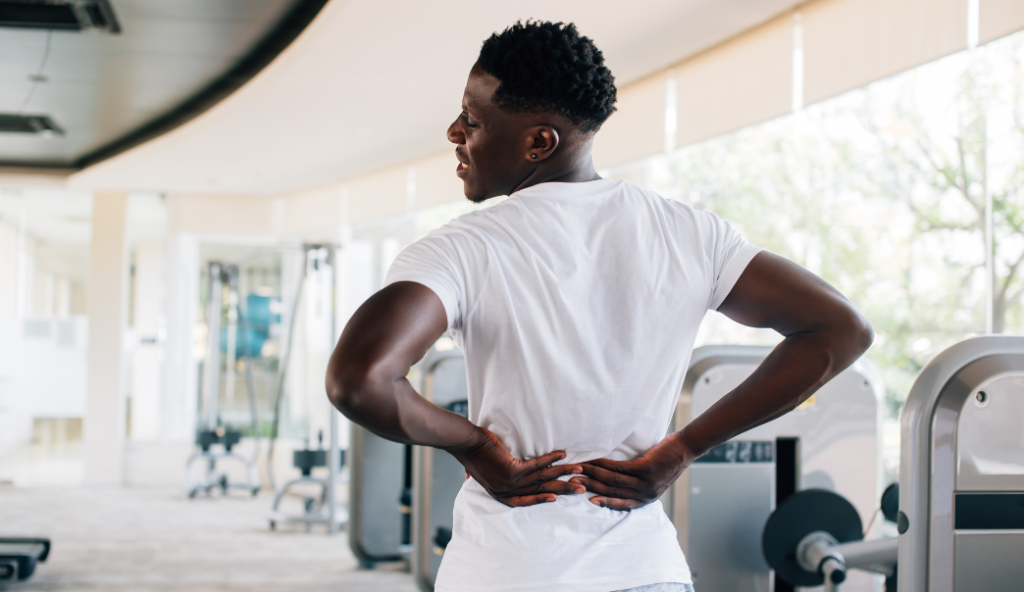Do you struggle with lower back pain after standing for long periods? You’re not alone. Many people experience discomfort in their lower back when standing for extended periods, whether due to work, household chores, or attending events. Luckily, there are effective ways to alleviate and prevent this pain.
In this article, we’ll explore the causes of lower back pain while standing, proven strategies to prevent and find relief from back pain, exercises to strengthen your body, expert advice on maintaining proper standing form, and resources for pain relief support. Let’s dive in!
Understanding the Causes of Lower Back Pain While Standing
Lower back pain is a common ailment caused by various factors. Understanding these causes is the first step towards finding the right solutions for alleviating and preventing them.
When it comes to lower back pain while standing, several common factors contribute to this discomfort. It is essential to recognize these factors to address the issue effectively:
Common Factors Contributing to Lower Back Pain
- Poor posture: Standing with improper posture can strain your back muscles and lead to pain. When you slouch or hunch forward, it puts unnecessary pressure on your lower back, causing discomfort over time.
- Weak back and core muscles: Your back and core muscles support your spine. When these muscles are weak, they cannot adequately support your spine, leading to increased stress on your lower back and resulting in pain.
- Lack of movement: Standing in one position for too long without taking breaks can lead to muscle fatigue and pain. When you remain stationary, the muscles in your lower back can become stiff and tense, causing discomfort and stiffness.
- Injury or previous back pain: If you’ve injured your back or have a history of back pain, standing for extended periods can aggravate the condition. The strain placed on your lower back can exacerbate any existing issues, leading to increased pain and discomfort.
How to Prevent Standing Back Pain
Now that we’ve identified some common factors, let’s delve into proven strategies to prevent back pain while standing.
Preventing lower back pain while standing requires a multi-faceted approach that addresses the underlying causes. Here are some strategies that have been proven effective:
- Maintain proper posture: When standing, keep your spine aligned and avoid slouching. Engage your core muscles to support your back and distribute the weight evenly.
- Strengthen your back and core muscles: Incorporate exercises that target your back and core muscles into your fitness routine. Strengthening these muscles will provide better support for your spine and reduce the risk of pain while standing.
- Take regular breaks and stretch: Avoid standing in one position for too long. Take short breaks to try and move around. This will help prevent muscle fatigue and stiffness in your lower back.
- Use proper footwear: Shoes with a lower or no heel can take pressure off of your back, and wider shoes allow your feet to spread out better and support you and your back.
- Practice good ergonomics: If your job requires prolonged standing, ensure your work environment is ergonomically designed. Use anti-fatigue mats, adjustable standing desks, and supportive chairs to minimize the strain on your lower back.
By implementing these strategies and consciously addressing the contributing factors, you can significantly reduce the risk of lower back pain while standing. Remember, prevention is vital when it comes to maintaining a healthy back.

Proven Strategies to Prevent Back Pain While Standing
Preventing back pain starts with adopting healthy habits and making mindful choices about your posture and movement. Here are some strategies to help you prevent back pain while standing:
Standing for extended periods can strain your back, leading to discomfort and pain. However, with the proper techniques and adjustments, you can minimize the risk of developing lower back pain. Maintaining good posture is one of the most effective ways to prevent back pain while standing.
Ergonomic Tips for Proper Standing Posture
Proper standing posture can significantly reduce the strain on your lower back. Here are a few ergonomic tips to help you maintain good posture:
- Align your ears, shoulders, and hips in a straight line.
- Distribute your weight evenly on both feet.
- Avoid slouching or leaning to one side.
- Engage your core muscles to stabilize your spine.
- Use supportive footwear that provides cushioning and arch support.
When you stand correctly, you allow your spine to maintain its natural curves, which helps distribute the weight evenly and reduces the strain on your back muscles. By aligning your ears, shoulders, and hips in a straight line, you create a balanced and stable foundation for your body.
In addition to maintaining proper posture, engaging your core muscles while standing is essential. Your core muscles act as a support system for your spine, helping stabilize it and preventing excessive strain. By consciously activating your core muscles, you can improve your overall posture and reduce the risk of developing back pain.
Choosing the proper footwear is another crucial aspect of preventing back pain while standing. A significant difference between the height of the heels and toes in your shoe can cause you to over-arch your back, and compressive, narrow shoes can mean that your feet aren’t able to stabilize you, meaning that muscles higher in your kinetic chain, including your back, have to work harder.
These ergonomic tips can minimize the risk of lower back pain while standing. However, if you’re already experiencing discomfort, finding relief is crucial. It’s important to listen to your body and take breaks when needed. Incorporating regular stretching exercises and gentle movements into your routine can help alleviate pain and prevent further discomfort.

Effective Ways to Find Relief from Back Pain After Standing
Finding relief becomes a top priority when lower back pain strikes after standing for long periods. Incorporating stretching and strengthening exercises into your routine can provide much-needed relief.
Stretching and Strengthening Exercises for Back Pain Relief
Combining stretching and strengthening exercises can help alleviate back pain and improve your overall condition. Here are a few exercises to try:
- Child’s Pose: This yoga pose gently stretches your lower back and promotes relaxation.
- Bird Dog: Strengthen your core and back muscles by extending one arm and the opposite leg while maintaining proper alignment.
- Bridge Pose: Engage your glutes and core to strengthen your lower back and hips.
- Cat-Camel Stretch: Alternate arching your back up (cat) and rounding it downwards (camel) to improve flexibility and relieve tension.
Incorporating these exercises into your daily routine can relieve back pain after standing. However, it’s essential to strengthen your body for improved standing endurance.
Strengthen Your Body for Improved Standing Endurance
Building strength and endurance in your back and core muscles is critical to withstand long periods of standing without pain. The following exercises target these muscle groups:
Targeted Exercises to Support Your Back and Core Muscles
Include the following exercises in your routine to strengthen your back and core muscles:
- Plank: This exercise engages your core, back, and abdominal muscles, building overall stability.
- Superman: Lie face down and simultaneously lift your arms and legs off the ground to engage your back muscles.
- Russian Twists: Sitting on the ground with bent knees, twisting your upper body from side to side to engage your oblique muscles.
- Deadlifts: Use proper form and technique to lift weights and strengthen your back muscles.
Regularly performing these exercises will improve your standing endurance, allowing you to tackle daily activities easily. However, to achieve long-term benefits, maintaining proper standing form is crucial.
Expert Advice on Maintaining Proper Standing Form
Who better to advise on maintaining proper standing form than physical therapists? Here are some tips from the experts:
Tips from Physical Therapists for Correcting Posture
Physical therapists recommend the following tips for maintaining proper standing form:
- Keep your head level, with your chin parallel to the ground.
- Draw your shoulder blades back and down.
- Engage your core muscles to support your spine.
- Relax your knees, avoiding locking them.
- Distribute your weight evenly on both feet.
By following these recommendations, you’ll be well on your way to maintaining proper standing form and reducing the risk of lower back pain. However, if you’re looking for additional support, consider exploring the benefits of Hinge Health.
Discover the Benefits of Hinge Health for Back Pain Management
Hinge Health offers a comprehensive digital program to help individuals manage and reduce back pain. Through personalized exercises, education, and one-on-one coaching, Hinge Health aims to empower individuals to take control of their back pain and improve their overall quality of life. Whether you’re suffering from back pain due to standing or other causes, Hinge Health may provide the support you need.
Exploring Options for Pain Relief and Support
In addition to exercises and proper form, various pain relief and support options are available. If you’re experiencing persistent or severe back pain, seeking professional advice is essential. Consider consulting with a healthcare provider, physical therapist, or chiropractor to explore the best course of action for your specific situation. Additionally, researching employer or health plan coverage options may help you access valuable resources and treatments to address your back pain effectively.
Resources for Finding Employer or Health Plan Coverage
When seeking employer or health plan coverage for back pain management, the following resources can be valuable:
- Benefits department: Contact your employer for available back pain management services coverage.
- Insurance provider: Contact your health insurance provider and discuss coverage options for back pain treatments, such as physical therapy or chiropractic services.
- Online forums and communities: Engage with online forums and communities where individuals share their experiences and recommendations regarding employer or health plan coverage for back pain management.
Remember, assistance is available if you need support managing your back pain through proper resources and coverage. Lastly, for those eager to learn more about this topic and delve deeper into research, here are some credible sources for further reading.
Credible Sources for Further Reading and Research
To further expand your knowledge on back pain and find additional research-based information, explore the following credible sources:
- Mayo Clinic: Visit Mayo Clinic’s website to access comprehensive articles covering various aspects of back pain, including causes, prevention, and treatment.
- WebMD: WebMD provides a wealth of trusted information on back pain and related topics, including symptoms, diagnosis, and self-care tips.
- National Institute of Arthritis and Musculoskeletal and Skin Diseases (NIAMS): NIAMS offers in-depth resources on back pain, its causes, and various treatment options.
- American Physical Therapy Association (APTA): APTA’s website features valuable information on how physical therapy can help manage and alleviate lower back pain.
By exploring these credible sources, you can enhance your understanding of lower back pain and make informed decisions regarding its management and prevention.
Ready to relieve lower back pain from standing?
In conclusion, lower back pain from standing can be effectively alleviated and prevented by understanding its causes and implementing proven strategies. Practicing proper standing posture, incorporating exercises to relieve pain and strengthen your body, maintaining good form, and exploring supportive resources are key steps toward finding relief and improving your overall well-being.
Consult with healthcare professionals to tailor a plan that suits your needs. With the right approach and support, you can conquer lower back pain and stand tall!


